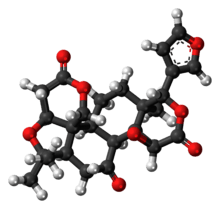Limonin
 | |
 | |
| Names | |
|---|---|
| IUPAC name
7,16-Dioxo-7,16-dideoxylimondiol | |
| Other names
limonoate D-ring-lactone, limonoic acid di-delta-lactone | |
| Identifiers | |
| 1180-71-8 | |
| ChEBI | CHEBI:16226 |
| ChEMBL | ChEMBL517449 |
| ChemSpider | 156367 |
| |
| Jmol-3D images | Image |
| PubChem | 179651 |
| |
| Properties | |
| C26H30O8 | |
| Molar mass | 470.52 g/mol |
| Except where noted otherwise, data is given for materials in their standard state (at 25 °C (77 °F), 100 kPa) | |
| | |
| Infobox references | |
Limonin is a limonoid, and a bitter, white, crystalline substance found in citrus and other plants. It is also known as limonoate D-ring-lactone and limonoic acid di-delta-lactone. Chemically, it is a member of the class of compounds known as furanolactones.
Sources
Limonin is enriched in citrus fruits and is often found at higher concentrations in seeds, for example orange and lemon seeds. Limonin is also present in plants such as those of the Dictamnus genus.[1]
Presence in citrus products
Limonin and other limonoid compounds contribute to the bitter taste of some citrus food products. Researchers have proposed removal of limonoids from orange juice and other products (known as "debittering") through the use of polymeric films.[2]
Bioactivity and research
Ongoing research programs are examining the effects of limonin in human diseases. Citrus seed extracts reportedly have antiviral properties, inhibiting replication of retroviruses like HIV-1 and HTLV-I.[3] Neuroprotective effects of limonin have also been described.[1] Limonin reduces proliferation of colon cancer cells[4] and has been tested as an anti-obesity agent in mice.[5]
References
- ↑ 1.0 1.1 Yoon, J. S.; Yang, H.; Kim, S. H.; Sung, S. H.; Kim, Y. C. (2010). "Limonoids from Dictamnus dasycarpus Protect Against Glutamate-induced Toxicity in Primary Cultured Rat Cortical Cells". Journal of Molecular Neuroscience 42 (1): 9–16. doi:10.1007/s12031-010-9333-1. PMID 20155333.
- ↑ Fayoux, S. P. C.; Hernandez, R. J.; Holland, R. V. (2007). "The Debittering of Navel Orange Juice Using Polymeric Films". Journal of Food Science 72 (4): E143–E154. doi:10.1111/j.1750-3841.2007.00283.x. PMID 17995766.
- ↑ Balestrieri, E.; Pizzimenti, F.; Ferlazzo, A.; Giofrè, S. V.; Iannazzo, D.; Piperno, A.; Romeo, R.; Chiacchio, M. A.; Mastino, A.; MacChi, B. (2011). "Antiviral activity of seed extract from Citrus bergamia towards human retroviruses". Bioorganic & Medicinal Chemistry 19 (6): 2084–2089. doi:10.1016/j.bmc.2011.01.024. PMID 21334901.
- ↑ Chidambara Murthy, K. N.; Jayaprakasha, G. K.; Kumar, V.; Rathore, K. S.; Patil, B. S. (2011). "Citrus Limonin and Its Glucoside Inhibit Colon Adenocarcinoma Cell Proliferation through Apoptosis". Journal of Agricultural and Food Chemistry 59 (6): 2314–2323. doi:10.1021/jf104498p. PMID 21338095.
- ↑ Ono, E.; Inoue, J.; Hashidume, T.; Shimizu, M.; Sato, R. (2011). "Anti-obesity and anti-hyperglycemic effects of the dietary citrus limonoid nomilin in mice fed a high-fat diet". Biochemical and Biophysical Research Communications 410 (3): 677–681. doi:10.1016/j.bbrc.2011.06.055. PMID 21693102.
External links
- PubChem Compound Summary
- "Citrus Compound: ready to help your body!" (Agricultural Research Service, USDA)